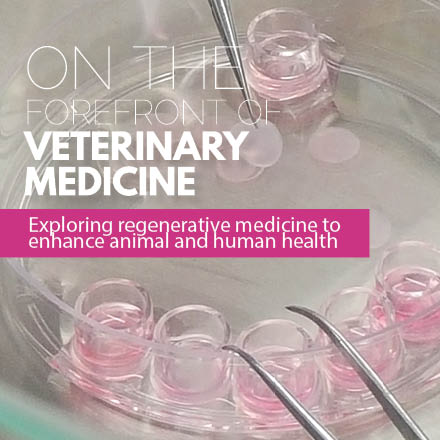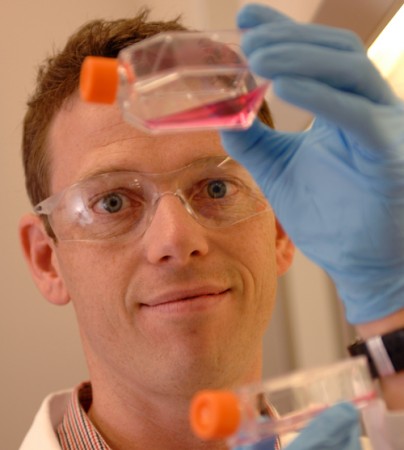Harnessing the power of stem cells has been a hot topic for a number of years in the scientific community.

Stem cells have the potential to be transformed into specialized cells that can act as an internal repair system or treatment for damage within the body. The National Institutes of Health (NIH) describes the potential benefits of stem cells in medicine: “Stem cells are distinguished from other cell types by two important characteristics. First, they are unspecialized cells capable of renewing themselves through cell division, sometimes after long periods of inactivity. Second, under certain conditions, they can be activated to become tissue or organ-specific cells with special functions. In some organs, such as the gut and bone marrow, stem cells regularly divide to repair and replace worn out or damaged tissues. In other organs, however, such as the pancreas and the heart, stem cells only divide under special conditions.”
A recent landmark veterinary study showed stem cells can be effective as a drug booster to help fight and cure drug-resistant infections in dogs. Stem cell therapy has also been used in cats to treat painful swelling caused by gingivitis, a type of gum disease.
The potential to speed up healing and cure disease is the main motivator for scientists to explore the area of regenerative medicine, the process of replacing, engineering or regenerating cells, tissues or organs to restore or establish normal function. This multidisciplinary research field combines developmental biology, materials science, cell biology, engineering and medical knowledge for treatment of various diseases and disorders.
Dr. Thomas Koch, an associate professor in the Ontario Veterinary College’s Department of Biomedical Sciences is at the forefront of veterinary and regenerative research in Canada. He is the Director of the Comparative and Translational Regenerative Medicine Network (CTRMN) at the University of Guelph. From human and animal health to food science, molecular, cellular and integrative biology to engineering, this network promotes collaborative work among 19 researchers that are investigating the emerging areas of stem cells, tissue engineering and regenerative medicine.
The main goal of the CTRMN is to further the development of new treatment opportunities that presently lack sufficient therapy options in humans and animals.
As a veterinary researcher, Koch has dedicated his career to studying regenerative medicine. Some areas in the body, such as the liver, have high regenerative potential. In comparison, joint cartilage does not regenerate. Koch’s research is focused on joint health.

“Cartilage, a connective and cushioning tissue found in many areas of the body, is unique from other organs or systems in the body; it has an extremely low cell count, and it’s a type of tissue without nerves or blood supply. When damage occurs in cartilage, there isn’t a lot of structure for cells to help it heal,” Koch explains. “Since cartilage generally wears over time, injury tends to go unnoticed until patients experience joint pain. Once pain occurs it is often too late to reverse the disease or the injury,” he adds.
Like humans, dogs, cats and horses suffer from a number of degenerative diseases such as osteoarthritis (the weakening of joint cartilage that leads to pain, stiffness and swelling) and elbow dysplasia (abnormalities with the elbow joint) with limited treatment options.
That’s where stem cells come into play.
“Manipulating stem cells can allow researchers to form different tissues under specific laboratory conditions,” says Koch. “This sets the stage for the possibility of engineering tissue to treat disease or injury.”
Koch’s lab is focused on exploring healthy and diseased states of joint cartilage from an evidence-based, scientific approach. While some cell-based therapies currently exist in the veterinary community, his goal is to determine: the best source and type of stem cells; the culture conditions of stem cells and how to direct their specialization into cartilage cells; and ultimately how to improve joint disease outcomes by developing better diagnostic procedures and treatment possibilities. His research involves engineering tissue using stem cells in his laboratory. The next goal for Koch is to take his bench research into a range of clinical trials.
The path from the laboratory to the clinic is often complex in many areas of medicine, and regenerative medicine is no different.
Koch and Dr. Tom Gibson, a small animal surgeon and certified specialist in veterinary sports and rehabilitation at OVC, are working together to find new solutions for elbow dysplasia in dogs. Common in larger breed dogs, elbow dysplasia is a lifelong disease for which there are currently very few treatment options. The disease often develops very quickly and can affect dogs at a young age. Koch and Gibson are collaborating with human health researchers at the University of Toronto to investigate a method to coax cells to become anti-inflammatory, a treatment that is currently being used in clinical trials for humans. Koch and Gibson hope to translate these findings into a clinical trial to help dogs.
On top of his work at OVC, Koch is the only veterinarian who sits on the Ontario Institute for Regenerative Medicine’s (OIRM) council, which is comprised of researchers and specialists working primarily in human regenerative medicine across the province.
Much of Koch’s research is recognized as a model for human disease.
“Mounting evidence suggests regenerative medicine can offer beneficial, sometimes even curative, results for specific diseases and conditions in our pets,” says Koch, acknowledging the area has the potential to transform veterinary medicine as we know it today. “Here at OVC, we have a unique opportunity to contribute to this evolving field of health that may benefit both animals and humans alike. The possibilities are so exciting.”
Read more in Best Friends Magazine.

